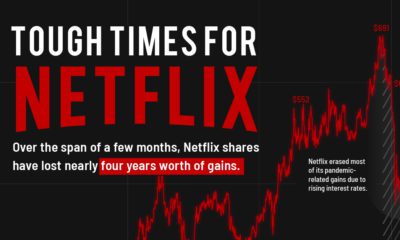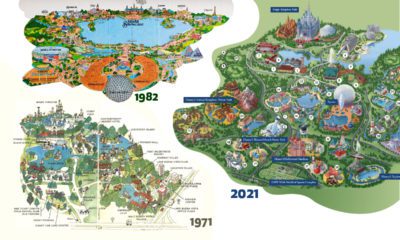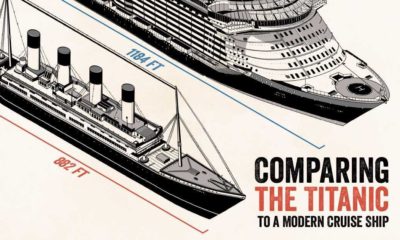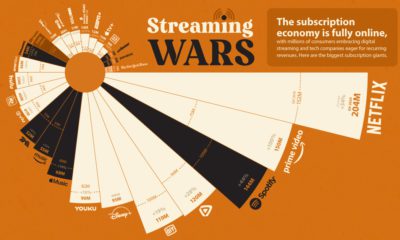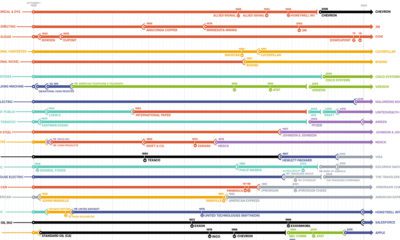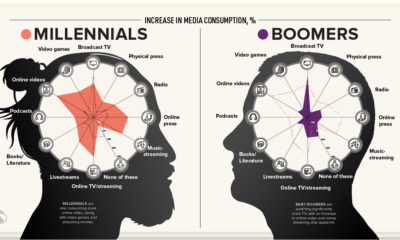With this in mind, here’s a look at the top grossing movies worldwide since the early 1990s, using data from Box Office Mojo. These figures include box office revenue as of May 2021, but don’t consider other revenue sources like merchandise sales.
The Full List: Top 50 Highest Grossing Movies
Coming in at number one on the list is Avatar—since its release in 2009, this Oscar-winning hit has grossed $2.84 billion in box office sales. Avatar cost $237 million to produce, meaning it’s turned a considerable profit over the years. But Avatar’s success was fairly unsurprising, considering the stellar track record of the film’s writer and director, James Cameron. Cameron also directed Titanic, which broke records back in 1998 when it became the first film to break $1 billion in worldwide box office revenue. In fact, Titanic was the top grossing movie for years, until Avatar stole its title in 2009. Interestingly, in 2019, Avatar was temporarily dethroned by Avengers: Endgame, which held the number one spot for a couple of years. But thanks to a recent theatrical reissue in China (which alone grossed an estimated $21.1 million) Avatar has since reclaimed its title as the top grossing movie worldwide. Avengers: Endgame remains a close second, with $2.80 billion in gross revenue. It’s one of 23 films in the Marvel Cinematic Universe (MCU) and besides Endgame, eight other movies from the MCU also appear on the top grossing movies list:
Avengers: Infinity War – #5 The Avengers – #8 Avengers: Age of Ultron – #11 Black Panther – #12 Iron Man 3 – #20 Captain America: Civil War – #22 Spider-man: Far From Home – #25 Captain Marvel – #26
Disney acquired Marvel Entertainment back in 2009. And while Marvel honored its existing contracts with other distributors, Disney owns the lion’s share of Marvel film rights and has earned over $18.2 billion as a result.
The Top Distributors
Marvel movies aren’t the only Disney productions to make the list. In fact, 26 of the 50 top grossing films were originally released by Disney, making it the top distributor. Warner Bros. and Universal Pictures tie for second. Warner Bros. was the domestic distributor of some pop culture classics like Harry Potter, The Dark Knight, and The Hobbit, while Universal Pictures released Fast and Furious, Despicable Me, and Jurassic Park. It’s worth mentioning that several of the distributors on the list are labels of larger studios. For instance, Warner Bros. is the parent company of New Line Cinema, Dreamworks is a branch of Universal, and 20th Century Fox was recently bought by Disney and rebranded to 20th Century Studios.
The COVID-19 Impact
The entertainment business was significantly impacted by the global pandemic, like many other industries across the globe. In 2020, global box office revenue totaled $12.4 billion—a 70% dip from 2019. Despite recent setbacks, industry professionals are feeling confident that things will recover post-pandemic. In a recent interview with The Deadline, Chairman of STXfilms Adam Fogelson said, “People like leaving their homes and having fun, emotional, communal experiences together…I don’t think that will change.” on Even while political regimes across these countries have changed over time, they’ve largely followed a few different types of governance. Today, every country can ultimately be classified into just nine broad forms of government systems. This map by Truman Du uses information from Wikipedia to map the government systems that rule the world today.
Countries By Type of Government
It’s important to note that this map charts government systems according to each country’s legal framework. Many countries have constitutions stating their de jure or legally recognized system of government, but their de facto or realized form of governance may be quite different. Here is a list of the stated government system of UN member states and observers as of January 2023: Let’s take a closer look at some of these systems.
Monarchies
Brought back into the spotlight after the death of Queen Elizabeth II of England in September 2022, this form of government has a single ruler. They carry titles from king and queen to sultan or emperor, and their government systems can be further divided into three modern types: constitutional, semi-constitutional, and absolute. A constitutional monarchy sees the monarch act as head of state within the parameters of a constitution, giving them little to no real power. For example, King Charles III is the head of 15 Commonwealth nations including Canada and Australia. However, each has their own head of government. On the other hand, a semi-constitutional monarchy lets the monarch or ruling royal family retain substantial political powers, as is the case in Jordan and Morocco. However, their monarchs still rule the country according to a democratic constitution and in concert with other institutions. Finally, an absolute monarchy is most like the monarchies of old, where the ruler has full power over governance, with modern examples including Saudi Arabia and Vatican City.
Republics
Unlike monarchies, the people hold the power in a republic government system, directly electing representatives to form government. Again, there are multiple types of modern republic governments: presidential, semi-presidential, and parliamentary. The presidential republic could be considered a direct progression from monarchies. This system has a strong and independent chief executive with extensive powers when it comes to domestic affairs and foreign policy. An example of this is the United States, where the President is both the head of state and the head of government. In a semi-presidential republic, the president is the head of state and has some executive powers that are independent of the legislature. However, the prime minister (or chancellor or equivalent title) is the head of government, responsible to the legislature along with the cabinet. Russia is a classic example of this type of government. The last type of republic system is parliamentary. In this system, the president is a figurehead, while the head of government holds real power and is validated by and accountable to the parliament. This type of system can be seen in Germany, Italy, and India and is akin to constitutional monarchies. It’s also important to point out that some parliamentary republic systems operate slightly differently. For example in South Africa, the president is both the head of state and government, but is elected directly by the legislature. This leaves them (and their ministries) potentially subject to parliamentary confidence.
One-Party State
Many of the systems above involve multiple political parties vying to rule and govern their respective countries. In a one-party state, also called a single-party state or single-party system, only one political party has the right to form government. All other political parties are either outlawed or only allowed limited participation in elections. In this system, a country’s head of state and head of government can be executive or ceremonial but political power is constitutionally linked to a single political movement. China is the most well-known example of this government system, with the General Secretary of the Communist Party of China ruling as the de facto leader since 1989.
Provisional
The final form of government is a provisional government formed as an interim or transitional government. In this system, an emergency governmental body is created to manage political transitions after the collapse of a government, or when a new state is formed. Often these evolve into fully constitutionalized systems, but sometimes they hold power for longer than expected. Some examples of countries that are considered provisional include Libya, Burkina Faso, and Chad.
